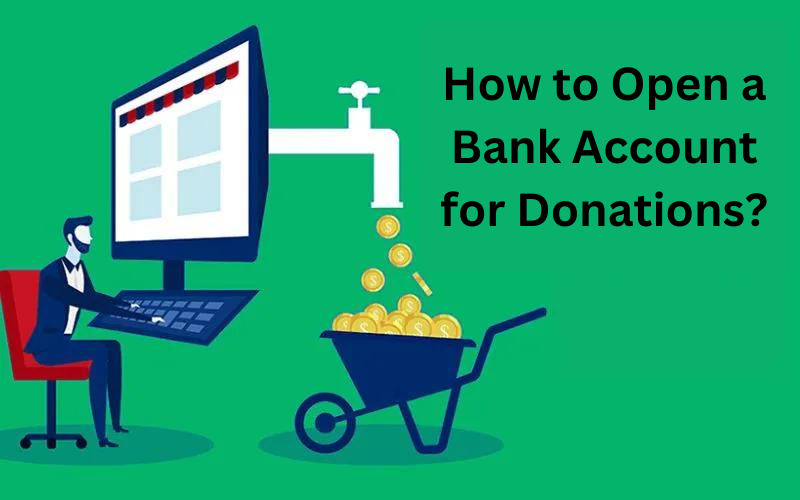Most charity organizations operate the money donated through the contributors. It is important to ensure the fund’s availability to fulfill the charity’s needs. That’s why a separate bank account for donations is crucial to ensure transparency.
Having a donation account will help contributors write a check directly for the charity organization and build trust among the organization and contributors. So, let’s learn how to open a bank account for donations and what challenges you may face to have an account for donations.
Receiving Donations in Personal Account: Risks and Challenges
You may face several risks and challenges if you receive donations in your personal accounts. However, if you want to receive donations in your personal account, you may need to know the following risks you may encounter.

1) Tax Implications
When you receive a donation in your personal account, the first risk you may face is the tax implication. You must report the donations on your tax returns. Moreover, donors cannot claim tax reduction for their contribution when they transact donations to your personal account. So, donate an account to avoid any amount deduction in the form of tax returns.
2) Transparency Challenges
Managing donation amounts in a personal account can lead to transparency challenges. It becomes difficult to demonstrate to the authorities how you use the funds. In addition, contributors may also feel inconvenienced while sending money to someone’s account. So, open a separate account associated with your organization to build trust and transparency.
3) Legal Concerns
Using your personal account for donation funding can lead you to legal concerns as it can expose your personal liability. So, keep them separate to secure your liability if any issue related to donation funding arises.
4) Tracking Challenges
Tracking and reporting about the donation funding becomes difficult if you use your personal account for donations. It leads to transparency and accountability issues. Moreover, it becomes challenging to provide updates if you or your organization use these funds for a specific project.
5) Reduce Trust
For charity organizations, it is important to achieve the trust of donors and contributors. It is only possible to provide them with fair accountability and transparency if you separate the funds and your personal transactions. Using your personal account for donations reduces the trust of contributors.
6) Growth Limitations
A personal account may not help you grow the donation volume due to the limitations of a non-profit account.
What Account is Used for Donations?
The type of account you may want to use for donations depends on the donations you receive. It depends on the organizations and individuals and the specific purpose of collecting them. However, you can use the following types of accounts to receive donations from contributors.
- Business bank accounts.
- Nonprofit or charity account.
- Online payment platform.
- Foundation accounts.
- Trust accounts.
A donation account is which type of account that only depends on charity organizations or individual preferences. Whatever account type you choose, it is important to ensure transparency and accountability so your contributors can trust your organization.
How Do I Open a Bank Account for Charity?
Most banks offer special current accounts for donations and charities. The best thing is that banks provide free banking services if the donation account is in credit. So, let’s learn how to open a bank account for donations and charity.
1) Choose a Bank
The first and most important step is to choose a bank where you want to open your charity account. For this, search for a bank that can meet your requirements about funding, process, and services they can provide to a charity account.
2) Documentation
Once you choose a bank, you may need to fulfill their requirements for documentation.
- You must prove your identity by providing a passport, government-issued ID, or driving license.
- You also must provide proof of your address by providing documents, which may vary according to the bank policies. However, usually, it may be a utility bill, electricity bill, bank, or credit card statement, etc.
3) Opening Your Account
After completing the documentation, you can open a charity account. Usually, banks have their own processes that may differ from other banks. So, follow the instructions given by the bank where you want to open an account. After completing the process, you may need to wait a few days to get essential documents from the bank, like a credit card, checkbook, etc.
Fundraising is one of the amazing sets specifically designed to hold donations. A fundraising bank account helps individuals, organizations, and groups to collect donations. These accounts facilitate the receivers and help them to track the activities for a specific fundraising purpose.
To account for charity donations, you may need to create an invoice for the services you donate, create an account for contributors, and issue credit notes for the customers. Verifying the notes, you apply to the invoice is important to keep them compatible.
Yes, you can open a bank account for a group. But it is good to give responsibility to someone to track the transactions to maintain transparency. Having a group bank account is a great way to keep the money saved as group members keep an eye on the donations and their expenditures.
Learning how to open a bank account for donation can help you to sustain transparency and accountability. Keeping your personal finances and donations separate is important to manage the tracking and reporting.
A donation account helps organizations and individuals avoid legal risks such as tax implications. To increase the growth rate of donations by developing trust among contributors and organizations by opening a charity account.
Final Words